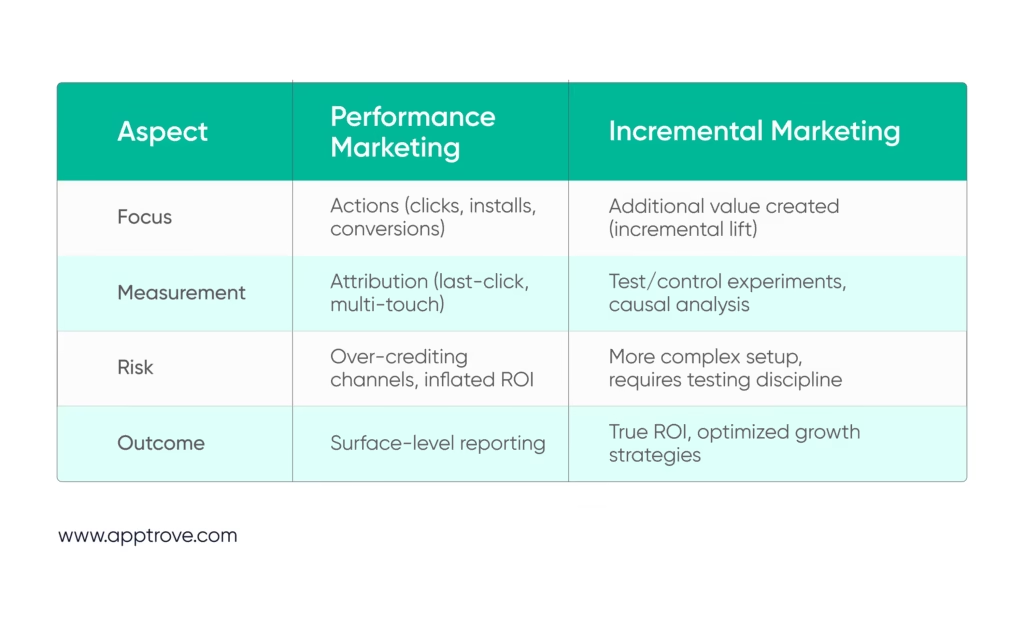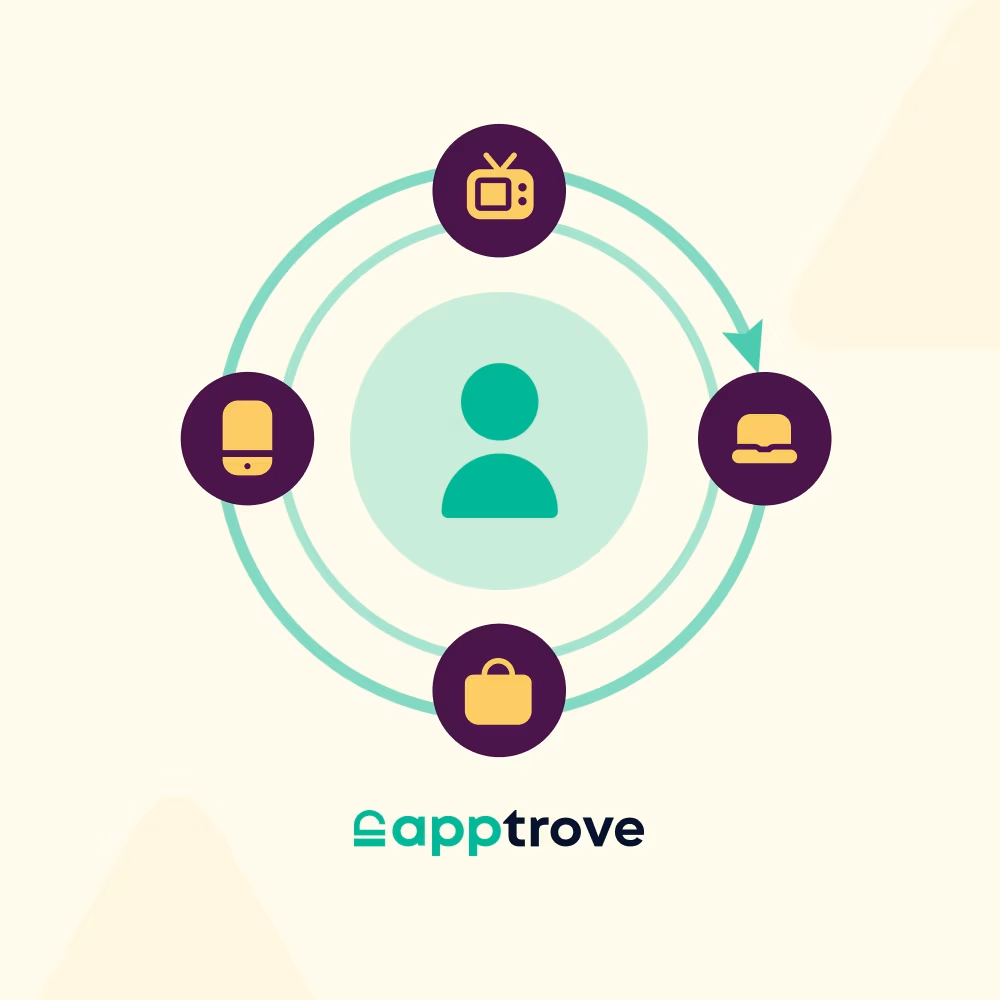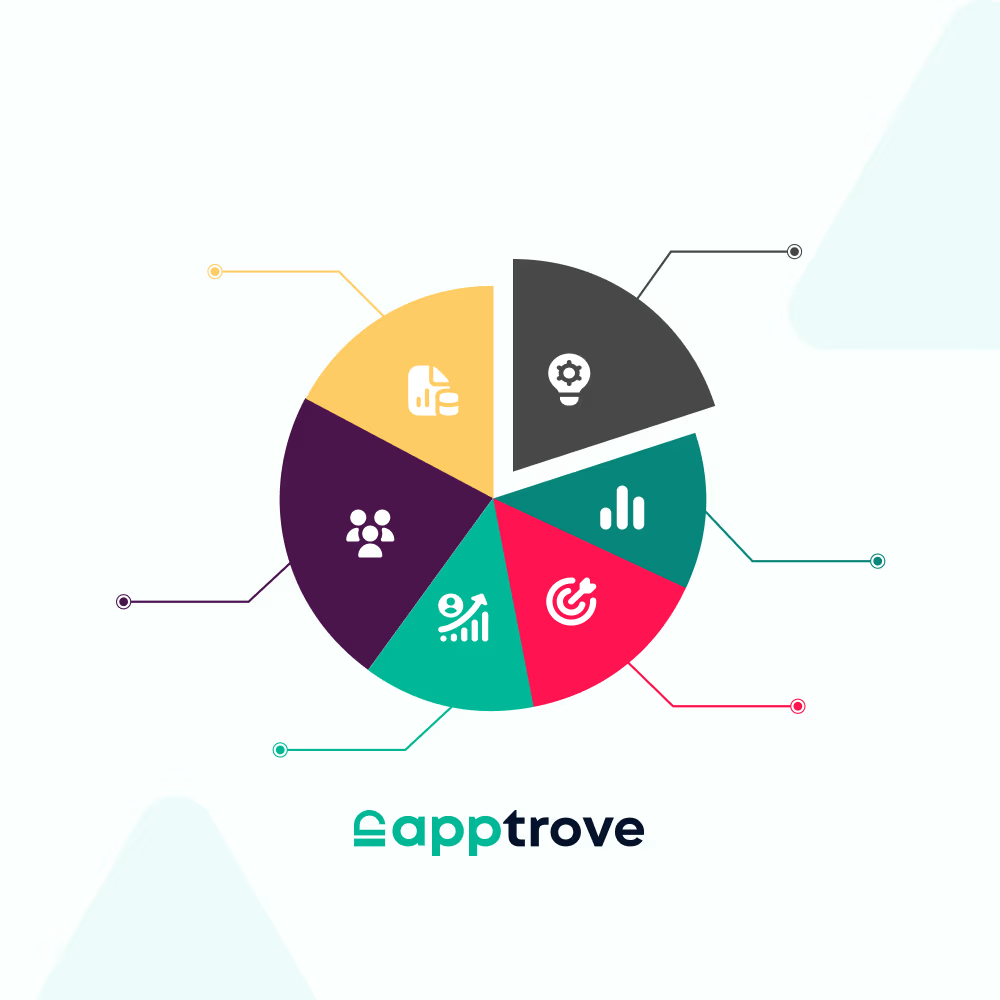While app marketing is now more measurable than ever before, it has also become more confusing. Dashboards are filled with CTRs, installs, CPAs, and conversions. Every ad network claims to be driving growth. But the catch here is that not every conversion you see reported was actually driven by your ad spending. Many conversions would have occurred regardless of your spending.
This disconnect between what you see reported and what is really created is the biggest blind spot for today’s app marketing. It’s why budgets often feel wasted and attribution reports rarely align with revenue, and it may even be why today’s performance marketers struggle to have real confidence in their work.
This is where incremental marketing comes into play. Rather than focusing on vanity metrics, incremental marketing simply asks what lift the campaign actually created. It’s not about measuring activity. It’s all about measuring impact.
If you are an app owner, developer, or performance marketer looking to maximize ROI for your app, incrementality is your advantage. At Apptrove, we help app-first businesses understand exactly how much true value their marketing creates.
What is Incremental Marketing?
Mobile app marketing is a tricky process. Users interact with ads across dozens of networks, from Meta and Google to TikTok, programmatic exchanges, and influencer placements. Many of these channels overlap; therefore, one install or subscription renewal is often attributed to several sources. If you don’t understand incrementality, it’s not clear where to attribute credit.
Incremental Marketing provides a framework to measure what percentage of app growth is simply driven by paid activity. It allows app owners to see the difference between organic momentum and advertising driven lift so that they can be confident the marketing budgets are being allocated to the channels that are actually delivering lift.
Instead of reporting total acquisitions, clicks, or purchases, it isolates and measures outcomes that wouldn’t have occurred without the campaign. In practice, this typically means stripping out inevitable conversions and reporting only the true incremental lift generated. So, a campaign may generate 10,000 installs, but only 3,000 of those installs were the result of advertising; in that case, the incremental value of that campaign is 3,000 installs, not 10,000.
This approach changes the conversation from measuring activity to measuring impact.
Incremental Marketing vs. Traditional Attribution
Traditional attribution models, including last click, first click, multi-touch, and view-through, involve assigning credit across campaigns. Though helpful for directional purposes, they do not imply causality.
- Last Click Attribution provides attribution to the last user touch point that occurred immediately before the conversion, even if the user had already intended to install.
- First Click Attribution provides attribution to the first user interaction at the beginning of the journey while discounting other influences along the way.
- Multi-Touch Attribution splits credit and attribution across multiple touch points, but often over-values and inflates the importance of some minor interactions.
- View-Through Attribution measures conversions where the user merely viewed the ad altogether or as part of a larger campaign, regardless of whether any action taken towards conversion was influenced.
None of these attribution frameworks can provide proof that the campaign caused the conversion. Therefore, while they provide a display correlation, they do not provide the right insight into causation.
Incremental Marketing solves this paradigm limitation. It pushes the conversation towards the campaigns’ unique net new contribution to growth beyond attribution. While this may seem subtle in the difference, it will be a game-changer for app marketers, specifically because it isolates the campaigns generating new revenue from the campaigns generating recycled or inflated revenue.

From Incremental Lift to Incremental ROI
Incremental analysis begins with measuring incremental lift (the increase in conversion that is attributable to the campaign). Lift is typically defined as follows:
(Treatment Conversions – Control Conversions) ÷ Control Conversions
This calculation yields the extra percentage of conversions generated as a result of marketing activity.
Next, marketers will work to establish incremental ROI. The nature of incremental ROI is the calculation of whether incremental conversions justify the marketing spend. A campaign may have generated lift (i.e. conversions), but if the cost of each incremental conversion exceeds user lifetime value, then the campaign cannot be justified financially.
By combining lift and ROI, marketers begin to have a complete perspective of how their campaigns performed in total, both from a behavioral and financial impact.
Why App Businesses Rely on Incremental Marketing
For app-first businesses, incremental marketing isn’t merely a luxury but an essential approach.
- User Acquisition Campaigns tend to over-report new users because many installs would occur organically. Incrementality shows how many new users were gained, net of organic installs.
- Retargeting Campaigns consistently show high engagement rates, but many of the users would have returned anyway. Incrementality helps filter out the noise.
- Finally, Subscription and Gaming Apps are driven by retention and revenue monetization. Incremental Return-on-Investment shows whether campaigns are generating sustainable growth, or short-term spikes.
With incremental marketing, app businesses can be confident that marketing is accountable, budgets are efficient, and growth strategies are sustainable.
The Rising Urgency of Incremental Marketing
Over the last five years, the marketing ecosystem has changed dramatically. Privacy-first laws, attribution limitations, and a proliferation of competing channels have changed performance marketers. In this environment, Incremental Marketing has gone from a competitive advantage to a necessity.
Traditional attribution models do not offer any clarity anymore. Most dashboards show overlapping claims of success, numbers that could be double counting, and metrics that do not connect. App owners and marketers that cling to outdated models waste budgets, misallocate resources, and scale based on false data.
Incremental marketing provides the evidence that modern-day growth strategies require. By controlling true impact from noise, it helps companies make decisions based on causality and financial accountability.
Market Forces Driving the Shift Toward Incremental Marketing
There are multiple factors that have made incrementality more urgent to adopt:
- Changing Privacy Regulations: With GDPR and CCPA and Apple’s App Tracking Transparency (ATT) limiting user-level data for marketers, incrementality thrives in this restrictive environment because it does not depend on deterministic identifiers for controlled experimentation.
- Attribution Limitations: The multi-touch attribution analysis that marketers used to analyze customer journeys has the same limitations of visibility as Apple’s SKAdNetwork and Google’s Privacy Sandbox. Incremental testing shares an analysis with a focus on the outcome instead of tracking a series of those steps.
- Channel Fragmentation: Users interact with advertising across Meta, Google, TikTok, programmatic exchange, and influencer campaigns, with each claiming success. If you don’t have incrementality, you have no reliable way to know who actually contributed.
- Budget Scrutiny: In mobile marketing today, every marketing dollar is under stress. Investors, CFOs and leadership want to see proof that campaigns depict my business’s growth that is measurable. Incremental marketing depicts that proof.
It’s no surprise that these factors make incrementality a strategic priority for performance marketers today and in the app economy.
Challenges Created by Attribution Inflation
Attribution inflation is one of the biggest challenges in app marketing. It happens when multiple networks take credit for the same conversion, inflating performance and concealing the truth about ROI.
- A user sees an ad of yours on TikTok, clicks a search ad on Google, and installs the app organically weeks later. TikTok and Google both report credit. Attribution reports now show duplication of a conversion when only one conversion occurred.
- A lapsed subscriber receives targeted email and also got alerted by push notifications. Both say they brought the user back, even if the return would have happened anyways.
Without incrementality, you are spending your budgets into campaigns with strong achievables looking on paper that have no contribution to real growth. Over time, this wears down your ROI and marketing strategy.
The True Cost of Ignoring Incrementality
Businesses that do not implement incremental marketing have multiple risks.
- Wasteful Marketing Spend: Paying for a conversion that would have occurred organically anyway.
- Over-Reliance on Retargeting: Not realizing how large the retargeting campaign budget will need to be to attempt to win back customers who would have returned naturally.
- Not Investing Enough In Organic Strength: Not recognizing and caring for organic channels because paid media is masking the effectiveness of the organic channel.
- Scaling on Non-incremental Data: Spending more on campaigns based on inflated metrics which leads to unsustainable growth and diminishing returns.
The costs go beyond just money. These things affect strategy, forecasting, and marketing’s credibility within the organization. Incrementality has consistently proven its value across industries. In one large-scale CPG meta-analysis, brands that ran advertising campaigns experienced a 14% increase in incremental sales compared to control groups. This shows us the true value of marketing is not the purported conversions’ raw number, but the lift that can be measured. App-first companies should also consider the incrementality in their marketing as the campaigns worth scaling are those that yield incremental value not inflated totals.
Incremental Marketing as a Strategic Framework
Incremental marketing involves more than measurement; it is a strategic framework that transforms how organizations pursue growth, making the impact of every decision evident. Budgets are then optimized based on incremental ROI, creative testing is validated through incremental lift, and retargeting is based on causal results instead of vanity metrics.
This creates a culture of accountability, where success is defined by real business growth in place of inflated numbers. For app-first business, this is the only way to successfully scale in a fragmented yet privacy-first world.
The Role of Incremental Marketing in App User Acquisition and Retention
The app economy presents one of the fiercest competitive ecosystems in digital marketing. Companies operate millions of apps in various categories, such as gaming, subscriptions, fintech, and e-commerce, and compete for user attention. In an economy so saturated with users and companies, any surface-level metrics can be misleading. Installs might be high, engagement might seem strong, and retargeting can look real, often leading to actual growth far below what is being presented in results.
This is exactly why Incremental Marketing is the new growth engine for mobile apps. Incremental Marketing enables marketers to see which campaigns are actually responsible for creating new users, generating purchases, and retaining subscribers. Instead of optimizing attributed installs based on inflated numbers, app businesses are able to optimize based on incremental lift and incremental ROI.
The Retargeting Reality Check
Retargeting has been promised as a high-performing channel for some time. Reports document users who have been won back at impressive rates; however, incrementality generally tells a different story. Many of the re-engaged users would have re-engaged on their own. In categories like gaming or subscription services, a large percentage of your re-engaged users typically become re-engaged users.
Incremental marketing is one discipline that will evaluate the retargeting objectively based on causal impact, rather than vanity numbers.
- Incremental lift in reactivation tells you how many users actually returned as a result of retargeting campaigns.
- Control group testing proves how many users would have returned anyway with no exposure to ads.
- Incremental ROI shows you the true cost of re-engaging users as it compares the cost of retargeting users to their natural rate of return.
For many app-first businesses, that analysis leads to the realization that they can reduce, or eliminate, their re-engaging spend and reallocating those dollars to higher-impact acquisition or engagement initiatives.
Subscription Apps: Measuring Sustainable Growth
Subscription-based applications, whether in health and fitness, media, SaaS, or beyond, are built on a recurring revenue model. Marketing campaigns that create a spike in short-term sign-ups mean nothing without measuring how many people stick around for the long-term.
Incremental marketing provides the structure in which to measure:
- The incremental lift in renewals attributed to push notifications, email reminders, or targeted ad campaigns.
- The incremental ROI of discounts or promotional offers – focusing on whether they generate net-new revenue and are not cannibalizing full-price subscriptions.
- Sustainable retention strategies that are validated through controlled experiments instead of worthless bounce metrics.
Subscription apps can ensure that the campaigns they run help drive recurring revenue and long-term growth through the lens of incremental value.
Gaming Apps: Clarifying Monetization
Gaming apps are among the heaviest spenders in mobile advertising. While user acquisition (UA) spending, along with monetization strategies in mobile apps, help drive growth, without incrementality, most of that spending will be misattributed or unaccounted for. Incremental marketing allows game app publishers to do the following:
- Determine the incremental lift in installs across ad networks. For publishers, this provides clarity around spending in the mobile advertising ecosystem that is often subject to overlapping attribution.
- Evaluate whether in-app purchases are driven by campaigns or whether these purchases would have happened anyway.
- Optimize event-based campaigns based on incremental return on investment (ROI) rather than inflated engagement data
For gaming studios that need to consider both scale and efficiency, incrementality will help ensure that millions of ad dollars are invested only to the extent they drive true impact in gaming apps.
Why Incremental Marketing is the App Marketer’s Compass
In the universe of mobiles, incrementality is the compass. It advances decision making by clearly differentiating between what appears to be effective and what actually is effective.
- App owners get clarity as to organic vs. paid growth.
- Developers understand how campaigns drive retention and engagement.
- Performance marketers can assign budgets to campaigns that drive proven and measurable incremental lift.
- Leadership can report on ROI through validated evidence rather than inflated attribution numbers.
Conducting Incrementality Analysis: A Step-by-Step Framework
Understanding the Incremental Marketing conceptually is not enough. Instead, to derive full value from incremental marketing, app businesses must apply a disciplined process to design, implement and interpret incrementality tests. It is in this part of the process that data becomes actionable and where we can see growth strategies shift from assumption-driven thinking to evidence-based decision making.
Incrementality analysis can be simplified into a clear and repeatable framework. Each step ensures that campaigns are assessed against the true impact on business, not on inflated vanity metrics.
Step 1: Define the Business Objective
Testing incrementality begins with specificity around the objective. App marketers need to determine what outcome they want to measure, This could include:
- Installs generated from a user acquisition campaign.
- Renewals for a subscription-based application.
- Re-engagements driven by retargeting ads.
- In-app purchases from a gaming based app.
By defining an objective, we can ensure the test generates relevant insight and eliminates ambiguity when assessing results.
Step 2: Select the Testing Methodology
This step requires selecting the right incrementality testing method, as approaches are different depending on the context:
Holdout Groups: A part of the audience is held out of ad exposure, so their natural behavior can be the baseline for comparison.
Geo-Based Tests: This involves implementing campaigns in one area, and withholding exposure in a similar region. This A/B testing methodology can be more effective when testing for large-scale tests.
PSA Tests: One of the goals of this method is to serve control groups neutral messages (such as public service announcements) instead of ads, so marketers can see baseline engagement without losing impression delivery.
Synthetic Controls: These are advanced statistical models that simulate a control group when real-world experimentation is not feasible.
Each of the methodologies mentioned has advantages and disadvantages related to scale, cost, and the effort to implement. Choosing the right approach will depend a lot on the size of the campaign and what data infrastructure is available to you.
Step 3: Establish Control and Treatment Groups
For incrementality analysis to be valid, these two comparable groups need to be set up:
- Treatment Group: Users who were exposed to the campaign.
- Control Group: Users who didn’t see the campaign, or saw a neutral message instead.
The difference in the outcomes across both groups represents the incremental lift you are estimating, induced by conducting the campaign. Randomization and statistical rigor will be critical to be able to estimate incrementality and avoid bias.
Step 4: Run the Campaign and Gather Data
After establishing the test groups, the defined campaign must be run for enough time to collect a statistically significant number of observations. Stopping the campaign prematurely may risk a faulty conclusion. Marketers will need to mitigate the impact of external factors such as seasonality, competitive advertising activity, and platform-specific anomalies that could distort results.
During this phase, raw outcomes are collected across each group, which might include installs, purchases, subscriptions, or other outcomes defined in advance.
Step 5: Calculate Incremental Lift
Incremental lift provides the quantitative measure of the true, causal impact of a campaign. Incremental lift can be calculated as follows:
(Treatment Conversions – Control Conversions) ÷ Control Conversions
For example, if the treatment group has 1,200 conversions, and the control group has 1,000 conversions, the incremental lift is 20%. In this example, this tells us that the campaign produced 20% more conversions than what would have happened without a campaign.
Step 6: Measure Incremental ROI
Incremental lift addresses the behavioral question of whether the campaign influence outcomes, while incremental ROI addresses the question of whether the investment was worth the cost.
Incremental ROI considers both the campaign cost and the value of incremental conversions. A campaign driving a 10% lift may still be unprofitable if each incremental conversion costs more than the user’s lifetime value.
When lift and ROI are combined, marketers have a real view of the campaign performance.
Step 7: Interpret Results and Reallocate Budget
The final step is translating insights into action. Incrementality results should inform:
- Which channels to scale
- Which campaigns to pause
- Where to allocate additional budget
- How to optimize the creative, targeting, or messaging to drive incremental lift
The process is cyclical. With each round of testing, it helps iterate on strategy so the marketing investment is always moving toward maximum efficiency.
Business Benefits of Incremental Marketing
Incremental Marketing changes how organizations strategize, measure, and optimize their growth strategy. Rather than operating on inflated reports, businesses have actual visibility into campaign performance and its impact on their business. This ability to see creates real measurement value from optimizing your budgets to fueling long-term scalability.
Smarter Allocation of Ad Spend
Marketing spend is limited. Without incrementality, businesses waste significant amounts of spend on campaigns that seem effective but add little to no incremental lift. Incremental marketing erases this inefficiency by demonstrating the exact campaigns that drive new growth.
- Poor-performing channels are identified and de-prioritized.
- High-performing campaigns receive increased investment.
- Neutral or negative campaigns are paused before they drain resources.
This results in a more efficient and effective budget where every dollar counts. For app-first or app-based businesses, this can also increase net growth while reducing total ad spend.
Accurate ROI Measurement
The common ROI calculations that contributed to the lack of trust in ROI is because traditional ROI calculations often inflate returns when they include conversions that would have happened anyway. Incremental marketing replaces it with incremental ROI, which is a metric that only considers causal results.
Clarity Between Organic and Paid Growth
One of the biggest challenges in marketing apps is separating organic growth from paid-driven results. It’s typical for apps to have organic growth through app store visibility, referrals, or brand recognition. However, paid campaigns layered on this growth can produce attribution reports that lead to false assumptions.
Incremental marketing helps to alleviate this issue because it evaluates the causal impact of paid activity in isolation. Marketers can gain visibility on:
- How much growth is organic.
- How much is driven by paid acquisition.
- Whether paid campaigns are amplifying or cannibalizing organic traction.
This knowledge provides marketers with the confidence that the paid budgets participate in the contribution to growth and not just take credit for what would have been realized otherwise.
Improved Retargeting Efficiency
Retargeting is notorious for inflated performance metrics. Many users “won back” by retargeting campaigns would have returned on their own. Incremental marketing exposes this reality and prevents overspending on inflated re-engagement. With incrementality:
- Retargeting campaigns are judged by incremental lift in reactivation.
- Control groups confirm the natural rate of return without ads.
- Budgets are reallocated to campaigns that produce genuine re-engagement.
This leads to leaner, more impactful retargeting strategies that support sustainable retention.
Long-Term Scalability and Growth
The potentially greatest advantage to incremental marketing is its role in scalability. Any business that is optimizing off of vanity metrics is inherently putting growth campaigns at risk, because it could simply lead to scaling campaigns that grow metrics but do not produce true value in the form of ROI, only increasingly diminishing returns and poor budget management will result.
Incremental marketing shifts the equation. Scaling only campaigns with an established or proven incremental ROI, a business may be able to build out a scenario for growth over longer-term horizons, with each dollar of incremental investment compounding true value.
For app-first businesses that compete in saturated categories, this becomes a durable competitive advantage. Growth is better not only faster, but smarter, and more sustainable, assessing all attribution reports as a percentage of inflated,
Challenges of Incremental Marketing and Overcoming Them
While the advantages of incremental marketing must be appreciated, implementing it effectively is not without challenges. Numerous organizations encounter limitations with structuring tests, understanding what the results mean, and infusing incrementality into their asset allocation. All of these can create friction in the adoption of Incremental Marketing and can, if left unchecked, negatively affect the accuracy of the results.
These are boundaries to acknowledge for app-first businesses. Understanding potential obstacles will allow marketers to think ahead and apply systematic solutions so their incrementality framework presents reliable insights that can inform better decisions for growth.
Technical Complexity in Experiment Design
To run an incrementality test and have the results be useful, organizations need to adhere to statistical rigor. Badly designed experiments often lead to erroneous results that either falsely inflate or deflate the impact of the campaign.
It is important for organizations to develop good experimental design principles. Testing with adequate sample sizes, randomization of users, and accounting for external factors addresses expectations for test results to be reflective of causal impact.
Data Availability and Privacy Restrictions
User-level identifiers are steadily becoming restricted, which means performance measurement when tracking a detailed journey is challenging, if not impossible. Typical attribution models are even less useful under these constraints.
Incremental marketing thrives even in privacy-first environments because it relies on aggregated experimental design rather than user-level tracking. Apptrove’s frameworks are designed with these privacy standards in mind.
Time and Resource Investment
Conducting your incrementality test does involve waiting time. Your standard campaign dashboards give you instant metrics to act on, incrementality will still require some time to reach statistical significance. Businesses with a fast-moving campaign may feel that the process is slow-moving or takes too many resources.
To overcome, look at incrementality tests as a long-term investment in efficacy. The first test might take some time, but the early gain in clarity provides much greater savings when it comes to future inefficiencies. Over time, it will be possible for organizations to add on automated tools and a repeatable framework of testing to help move timelines up and use fewer resources in the process.
Interpreting Complex Results
Incrementality outputs can be more complex than standard KPIs. Lift percentages, control group variances, and incremental ROI calculations require statistical literacy to interpret correctly. Without the right expertise, marketers risk misapplying insights.
Results must be translated into actionable insights. By presenting data in terms of budget allocation, ROI, and actionable recommendations, you can ensure results are both accurate and accessible.
Organizational Resistance to Change
Perhaps the most overlooked challenge is cultural. Many teams are accustomed to reporting success based on inflated vanity metrics. Shifting to incrementality often means challenging long-held assumptions and redefining what success looks like.
Adoption requires education and alignment. Incremental marketing must be positioned not as a critique of past performance, but as an evolution toward more accurate, accountable growth measurement. Apptrove partners with businesses to build internal understanding, ensuring stakeholders embrace incrementality as the new standard.
Incremental marketing may be complex, but it is not inaccessible. The key to success lies in structured implementation and expert guidance.
Businesses that ignore incrementality based solely on the mistaken notion of a more complex approach bear the true risk of significant loss in terms of inefficiency in spend and decisions. Alternatively, firms that adopt incrementality despite the challenge actually receive a competitive advantage. Such companies scale on the basis of evidence, optimize budgets with precision, and generate growth in a way that can be both measured and defended.
Incremental marketing is more than just another metric to track, it is the cornerstone of evidence-based marketing.
The Future of Incremental Marketing in Mobile Growth
The momentum of change in digital and mobile marketing is not slowing down. Over the course of the next ten years, new privacy frameworks, new capabilities in AI, and consumer behavior changes will further change how performance is measured. In this environment, incremental marketing will go from being a best practice to the standard framework for assessing campaign effectiveness.
For app-first businesses, this transition will bring both challenges and opportunities. Marketers who adapt early will create lasting competitive advantages, while those who continue to use outdated attribution models will struggle with efficient scale.
Apptrove sees incrementality not as a temporary solution but as the long-term foundation for app growth. Our mission is to help businesses transition from attribution to causation, from inflated reporting to evidence-based performance. Join today!







